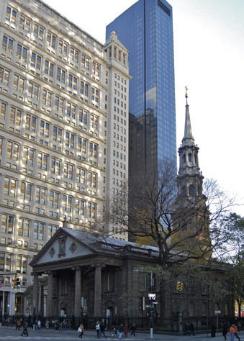

12
BCD Special Report on
Historic Churches
17th annual edition
One way that developers can enhance projects
on sites adjacent to landmarked religious
properties is through the purchase or leasing
of ‘air-rights’. Tis transferral of potential
development concerns the empty space
above a building – its air rights. Depending
on the limits imposed in a particular zoning
area, square footage that cannot be used
on the original site may be ‘transferred’ to
enable a developer to build a larger building
on an adjacent site. Efectively, the church is
selling the diference between the actual built
foor area on its plot and the maximum it is
allowed under local zoning regulations. Tis
might mean, for example, that the purchasing
developer adjacent to the church is allowed to
build a 55 storey building instead of a 30 storey
building (pending approval by the Department
of City Planning and the Board of Standards and
Appeals for the appropriate zoning waivers).
By selling air rights in this way, the
owners of historic churches in New York
City have been able to receive considerable
compensation without physical loss of their
assets and, from the community’s perspective,
the increase in density is often considered a
fair trade to preserve an important building
and a valued element of the streetscape.
Te ‘transfer’ of foor area from one site to
another can upset the scale and character of a
residential neighbourhood, but there is rarely
opposition when it involves a religious site.
One of the more successful air-rights
transfers beneftted the Church of the
Transfguration, also known as ‘the Little
Church Around the Corner’ (1849). Although
the original parish house was demolished to
make way for a 55-storey luxury apartment
building, the latter incorporates a new three-
storey parish house completed in 2008. Te
courtyard and the lych-gate designed by
Frederick Clarke Withers remain (page 13).
Te trend of churches selling sell air-
rights is gaining momentum. Despite the
economic downturn in real estate, developers
are assembling parcels to capitalise on their
investment by building taller. One recent
project is close to Times Square at the Church
of the Holy Cross, (Henry Englebert, 1854).
Developers were permitted to build more
foors at an adjacent site in a complicated real
estate deal that included upgrading of-site
tenement buildings as part of an inclusionary
housing arrangement. Te zoning issues
when assembling development parcels are
becoming increasingly complex, but they
remain potentially very proftable for both
developers and churches in need of funds.
At the time of writing, new construction
in the city has virtually stopped, with a handful
of projects nearing completion and a few
large-scale developments at the planning
stage. With government subsidies for housing
drastically curtailed, and borrowing for
speculative development impossible to secure
at a reasonable cost, there is a temporary
hiatus. Community advocates for responsible
development and those seeking to press
forward with landmarking see this period
as the perfect opportunity with little or no
competition in the real-estate market.
Landmarking and stewardship
While the selling of air-rights is undoubtedly
highly contentious, the most pressing
debate remains whether houses of worship
should become designated landmarks, and
if so, who should make that decision: the
congregation, which has a vested interest
in the worship space and is involved in the
day-to-day operation of the building, or
members of the public, who appreciate the
religious building from the exterior only
and as a component in the streetscape.
As benign as a designation or a National
Register listing may seem, not all churches
believe that landmarking is necessary or even
appropriate. Tere is deep-rooted concern that
designation works against the mission of many
congregations. No matter how well meant,
regulations are seen, initially at least, as purely
restrictive. Landmark designation can therefore
be a double-edged sword: if there is neither
the incentive nor the funds to maintain it, the
religious building property can deteriorate
to a state referred to in the US as ‘demolition
by neglect’. If, however, there is a willing and
viable congregation, there are programmes
that can provide technical assistance and in,
certain cases, fnancial support to repair and
preserve the house of worship. When the owner
supports designation there is no controversy
St Mark’s Church-in-the-Bowery (Ithiel Town, 1795 with later additions by James
Renwick and WJ Russell in 1883). Te parish house, rebuilt by Ernest Flagg in 1899
was restored in 1999.
St Paul’s Chapel, lower Manhattan, attributed to the architect Tomas McBean
and mastercraftsman Andrew Gautier, 1766. Modelled after St Martin-in-the-
Fields, Trafalgar Square, London, it is the oldest surviving church in Manhattan.
Behind the church is the former World Trade Center site.